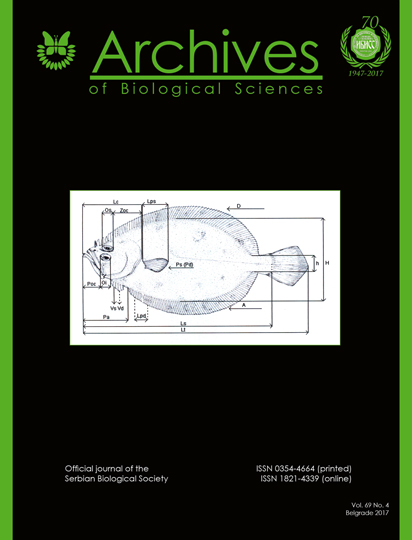Morphometric and meristic traits of megrim, Lepidorhombus whiffiagonis (Walbaum, 1792) from the eastern central Adriatic Sea
Keywords:
fish, teleostei, Scophthalamidae, morphology, classical biometric measurementsAbstract
The relationship between classical morphometric measurements (12) and meristic traits (8) was examined in 435 specimens of megrim (214 males, 221 females) caught in the eastern central Adriatic Sea. Total length of all specimens ranged from 9.0 to 34.6 cm. Morphological differences between males and females was not marked. Biometric analysis of the morphometric and meristic traits indicated a homogenous morphology stock of Lepidorhombus whiffiagonis in the eastern central Adriatic Sea. Changes in some morphometric traits obtained in conjunction with an increase in body length showed that smaller specimens have longer standard length, head, pectoral fins and preanal distance than adult specimens. The positive correlation recorded for the maximum body height indicated that the body slightly shortened with megrim growth. The morphometric and meristic traits of megrim from different Mediterranean and northeastern Atlantic areas are mostly in accordance with previously published articles.
https://doi.org/10.2298/ABS170214012S
Received: February 14, 2017; Revised: March 13, 2017; Accepted: March 25, 2017; Published online: April 4, 2017
How to cite this article: Šantić M, Pallaoro A, Markov M, Jardas I. Morphometric and meristic traits of megrim, Lepidorhombus whiffiagonis (Walbaum, 1792) from the eastern central Adriatic Sea. Arch Biol Sci. 2017:69(4):665-70.
Downloads
References
Nielsen JG. Pleuronectiformes. In: Whitehead PJP, Bauchot ML, Hureau JC, Nielsen J, Tortonese E, editors. Fishes of the north-eastern Atlantic and Mediterranean. Vol 3, Paris: UNESCO;1986. p. 1015-73.
Jardas I. Jadranska ihtiofauna. Zagreb: Školska knjiga; 1996. 523 p.
Grubišić F. Ribe, rakovi i školjke Jadrana. Zagreb, Rijeka: ITRO Naprijed, GRO Liburnija; 1988. 239 p.
Fishery and Aquaculture Statistics, FAO yearbook: 2014. 76 p.
Karlovac O. Plosnatice roda Lepidorhombus (Pisces) u Jadranu. Pom Zbor. 1975;13:501-10.
Šantić M, Pallaoro A, Jardas I, Podvinski M, Kirinčić M. Feeding habits of megrim, Lepidorhombus whiffiagonis (Walbaum, 1792) from the central Adriatic Sea. J Appl Ichthyol. 2009;23:279-81.
Šantić M, Stagličić N, Pallaoro A, Markov M, Jardas I. Age and growth of megrim Lepidorhombus whiffiagonis (Scopthalamidae) from eastern Adriatic Sea. Cybium. 2013;37:255-61.
Dieuzide R, Novella M, Roland J. Catalogue des poissons des Cotes Algeriennes. Bull Trav Publ Stat Aquicult Pech Castig. 1955;3:1-384.
Dwivedi SN. Ecologie, morphologie comparées des deux espèces du genere Lepidorhombus: L. whiffiagonis et L. bosci. Etude de leurs race set populations. Rev Trav Inst Pêches Marit. 1964;28:321-99.
Bini G. Gadidae. In: Atlante dei pesci delle coste italiane. Vol 4, Osteitti. Milano: Mondo Somerso; 1968. p. 93-4.
Tortonese E. Osteichthyes (Pesci ossei). Vol 11, Fauna d Italia. Bologna: Calderini;1975. 636 p.
Bauchot ML. Scophtalamidae. In: Fischer W, Schneider M, Bauchot ML, editors. Fishes FAO d identification des espèces pour les besoins de la pêche. Méditerranèe et Mer Noire. Vol 2. Rome: FAO; 1987. p. 1173-4.
Robson SM, King PA, Mc Grath D. The morphometric and meristic characteristics of common megrim Lepidorhombus whiffiagonis and four-spot megrim Lepidorhombus bosci from off the west coast of Ireland. Ir Nat J. 2005;28:116-9.
Furnestin J. Le cardine (Lepidorhombus megastomus Donovan = Lepidorhombus whiffiagonis Walbaum). Résuméş des connaissances acquises sur la biologie de ce poisson. Rev Trav Inst Pêches Marit. 1935;8:203-49.
Başusta N, Akyurt O, Girgin A. The first record of megrim, Lepidorhombus whiffiagonis (Walbaum 1782) in Iskarun Bay. Split: Bilj Inst Oceanogr Ribar; 2000. p. 6.
Straüss RE, Bond CC. Taxonomic methods: morphology. In: Schreck CB, Moyle P, editors. Methods for fish biology. Bethseda, Maryland: American Fisheries Society; 1990. p. 125-30.
Ihssen PE, Booke HE, Casselman JM, Mc Glade JM, Payne NR, Utter FM. Stock identification: Materials and methods. Can J Fish Aquat Sci. 1981;38:1838-55.
Sokal RR, Rohlf FJ. Biometry. San Francisco: WH Freeman and Company; 1981.
Carvalho I. Evolutionary aspects of fish distribution: genetic variability and adaptation. J Fish Biol. 1993;43:57-73.
Mamuris Z, Apostolidis AP, Panagiotaki P, Theredorou AJ. Triantaphyllidis C. Morphological variation between red mulletpopulations in Greece. J Fish Biol. 1998;52:107-17.
Quilang JP, Basiao ZU, Pagulayan RC, Roderos RR.. Barrios EB. Meristic and morphometric variation in the silver perch, Lepiotherapon plumbeus (Kner, 1864), from three lakes in the Philippines. J App Ichthyol. 2007;23:561-67
Blaxter JS. Herring rearing-III. The effect of temperature and other factors on myotome counts. Mar Res. 1957;1:1-16.
Downloads
Published
How to Cite
Issue
Section
License
Authors grant the journal right of first publication with the work simultaneously licensed under a Creative Commons Attribution 4.0 International License that allows others to share the work with an acknowledgment of the work’s authorship and initial publication in this journal.




